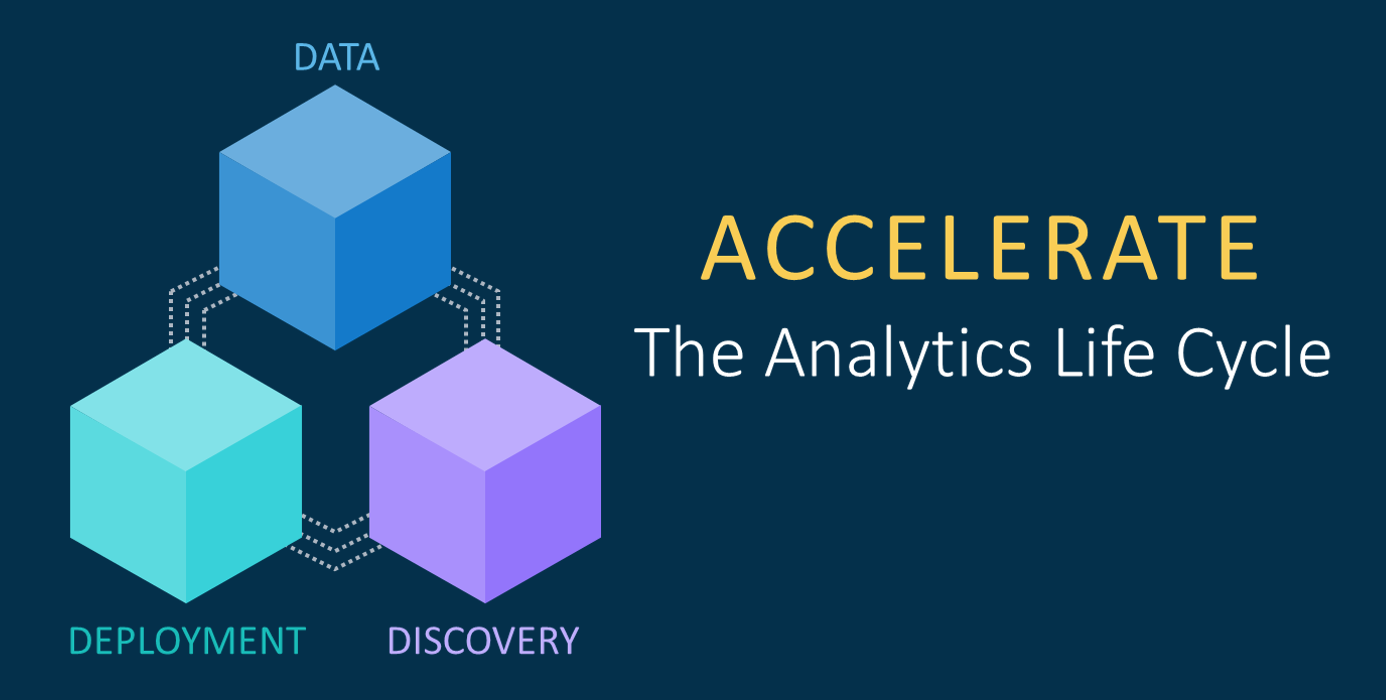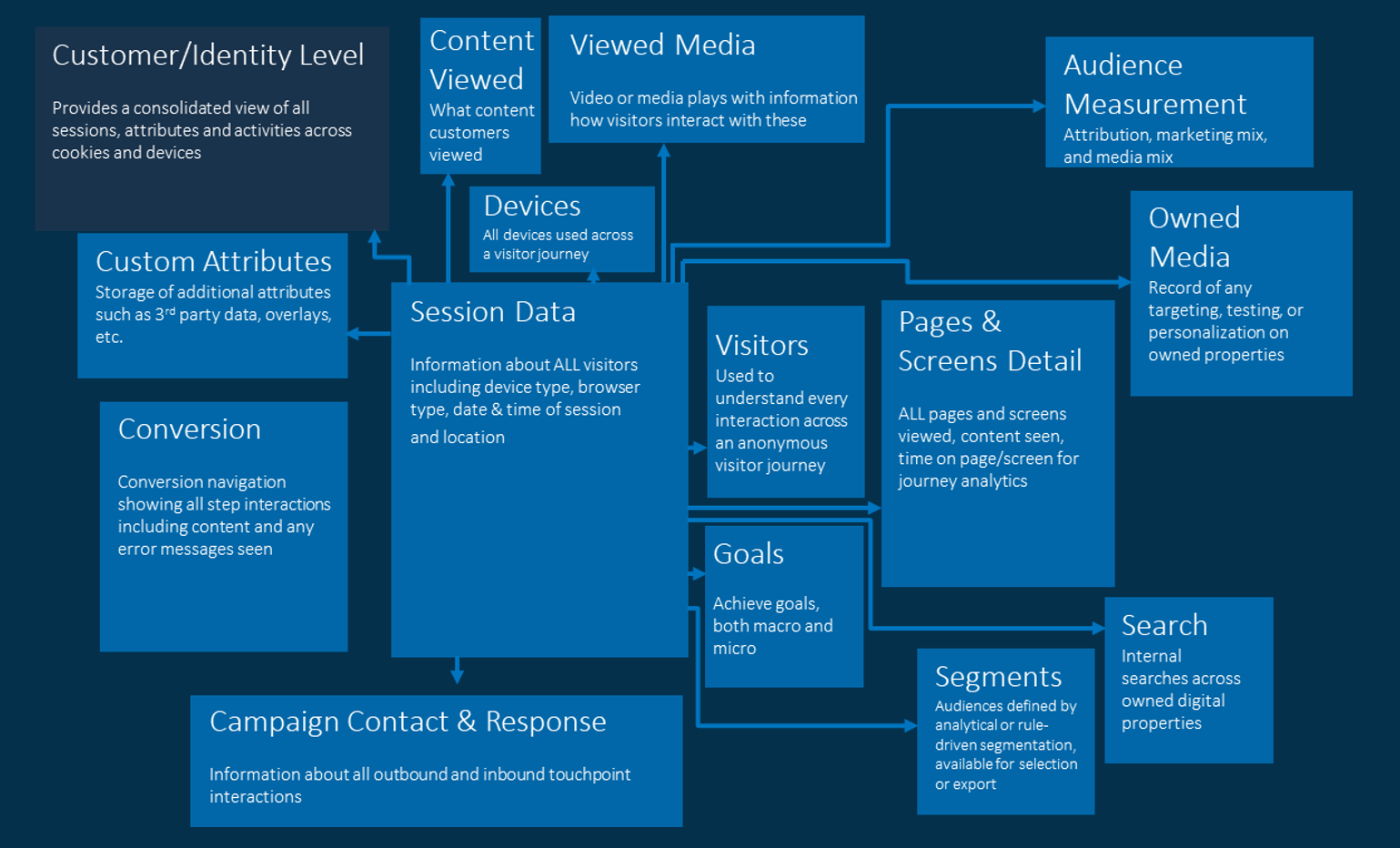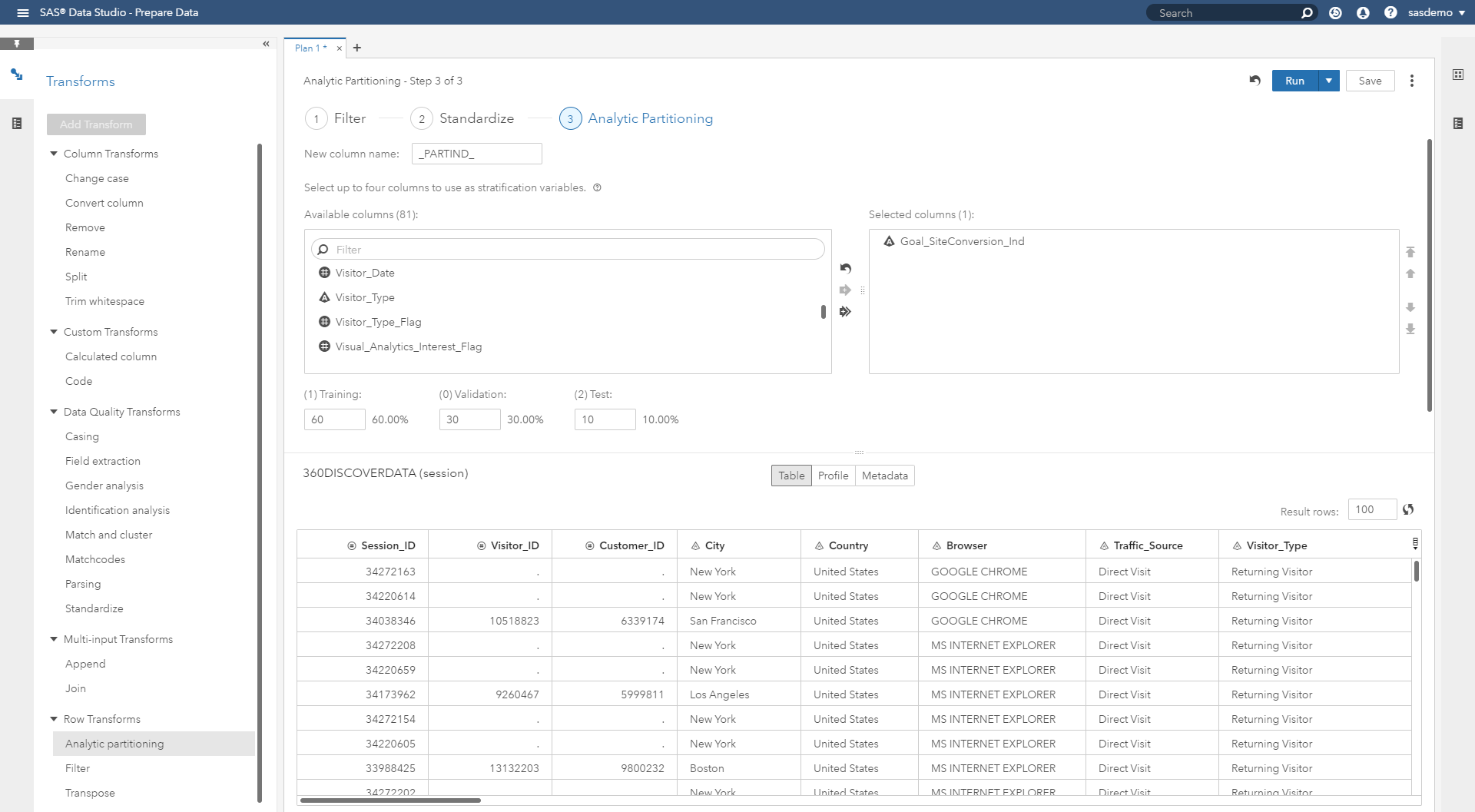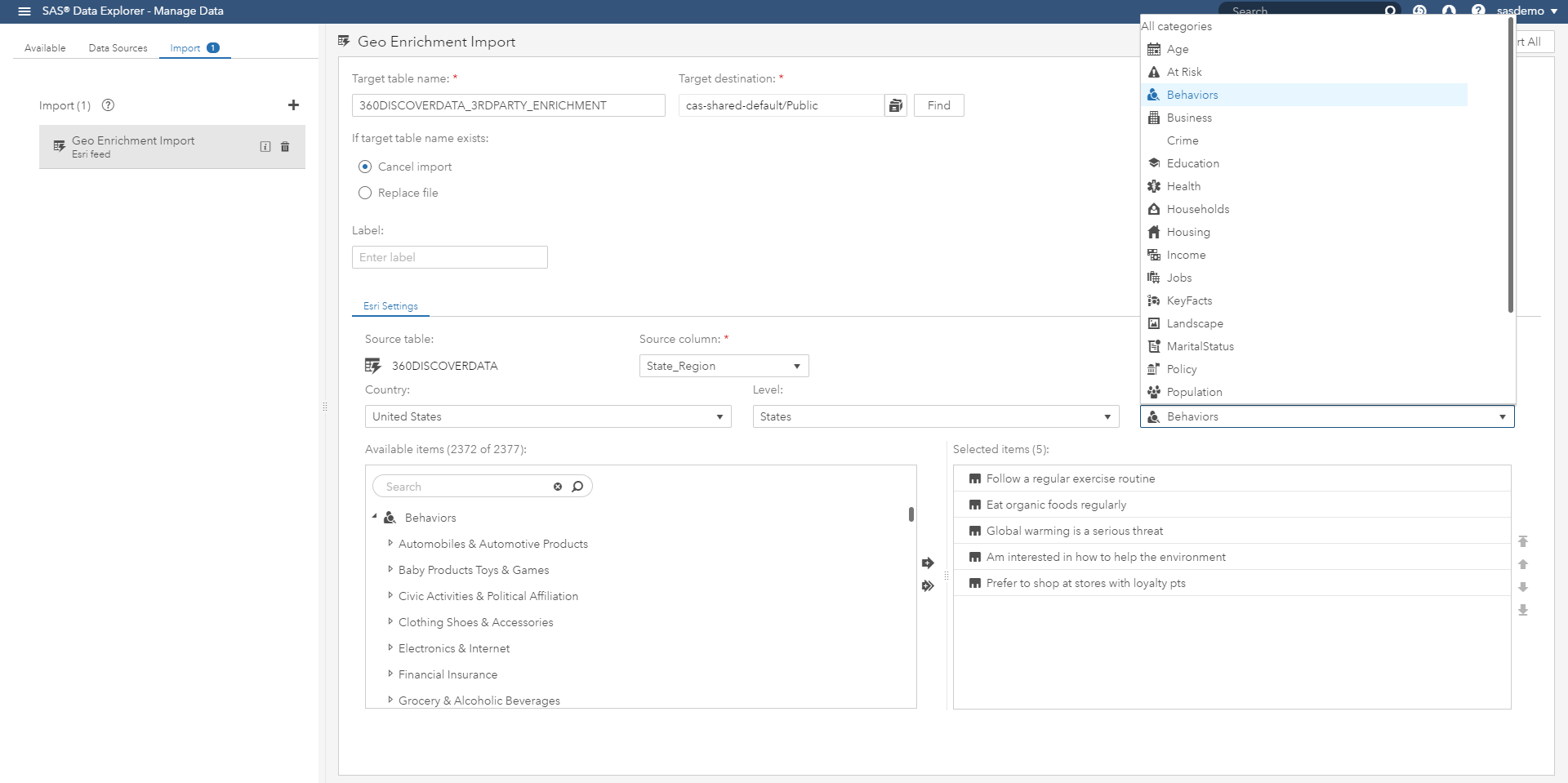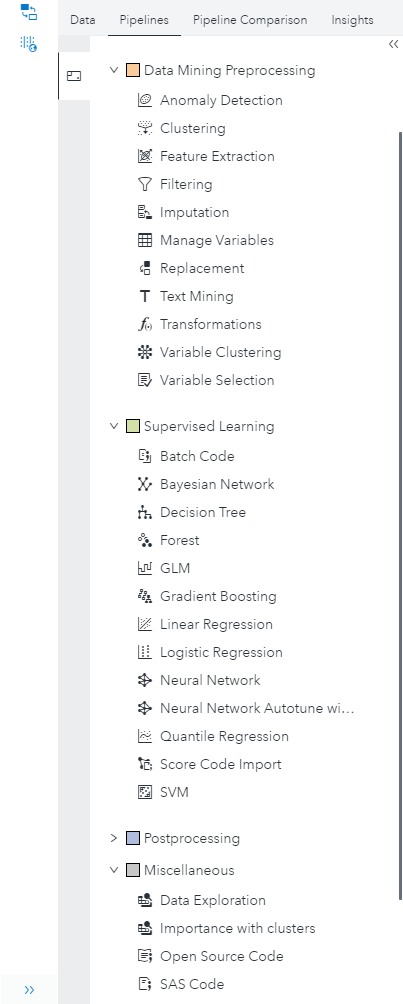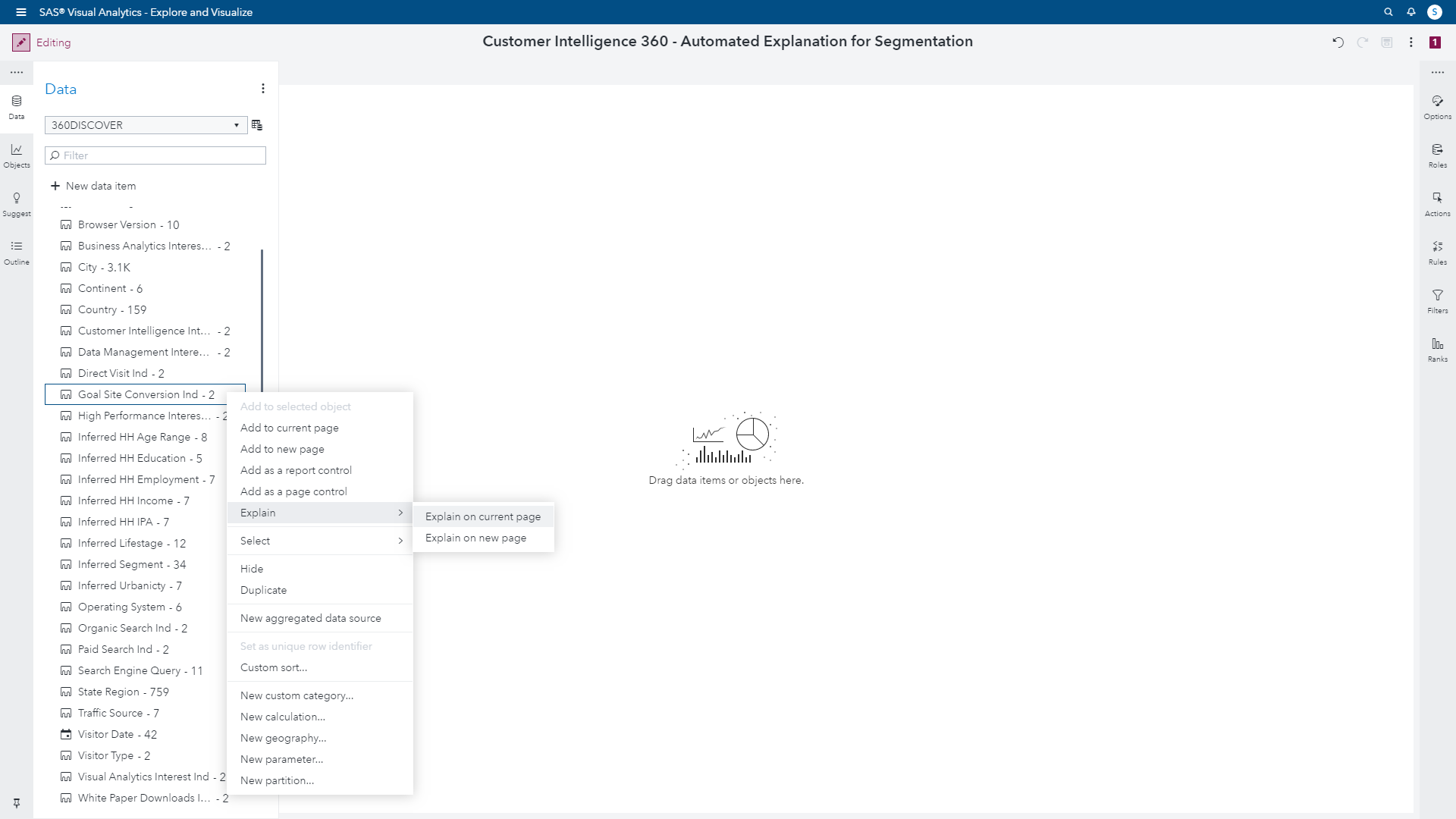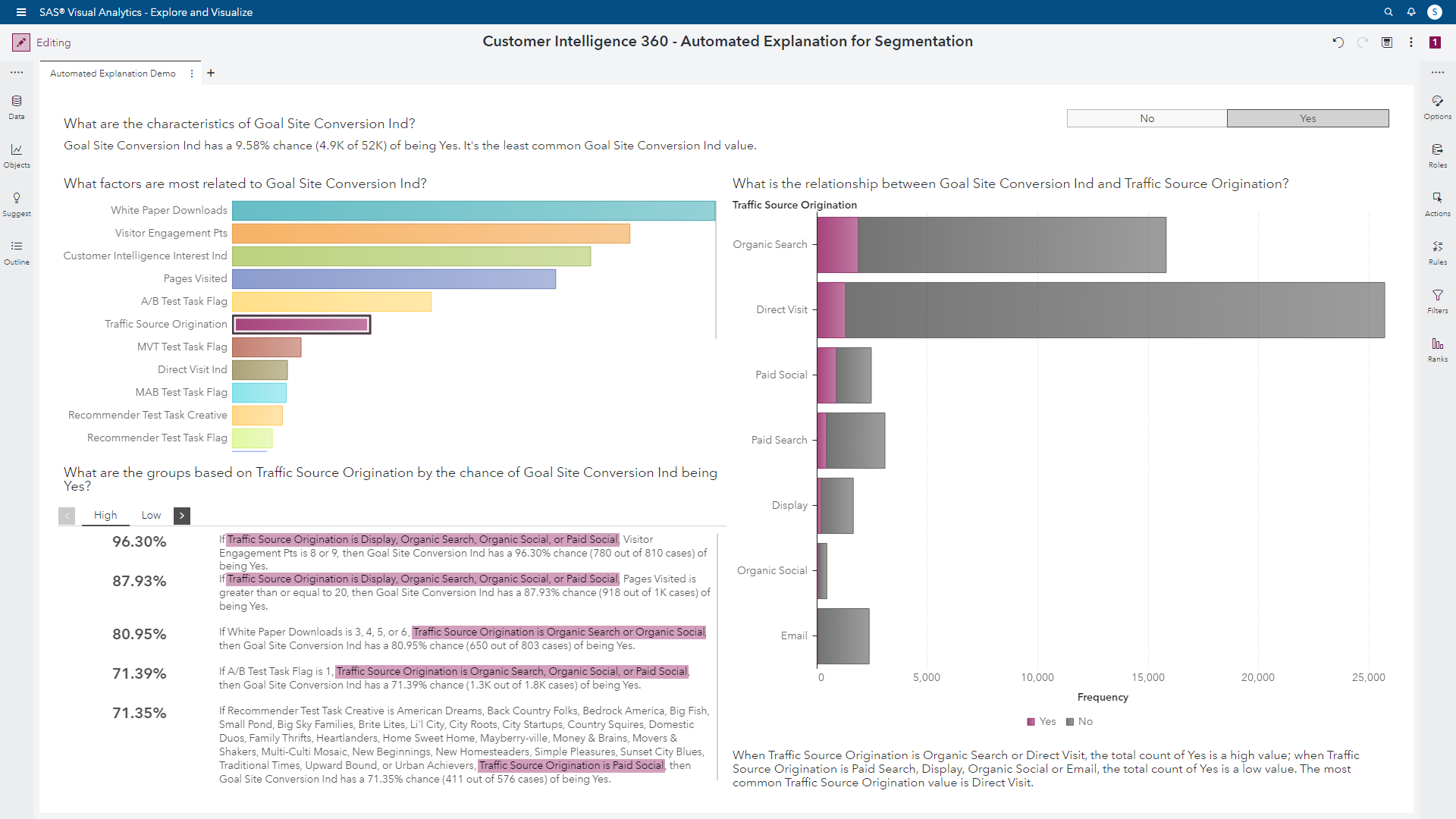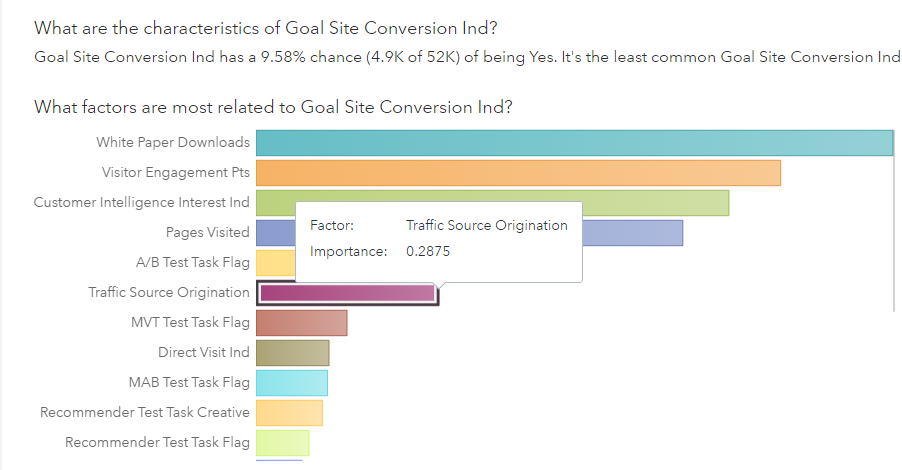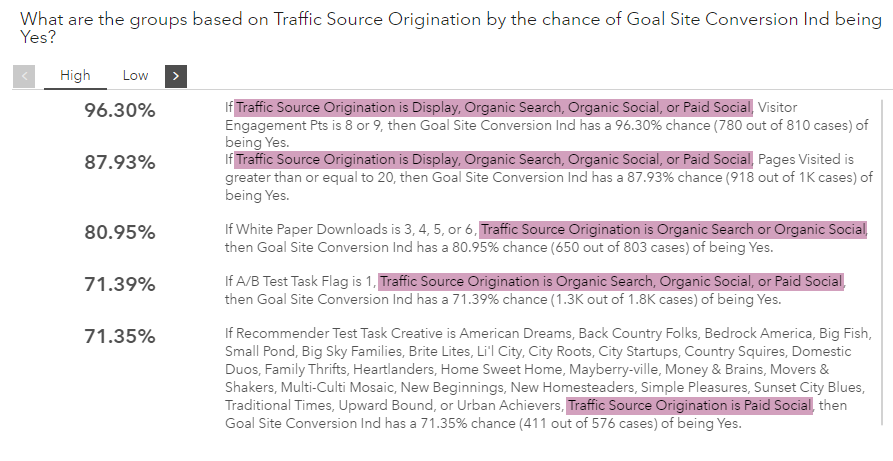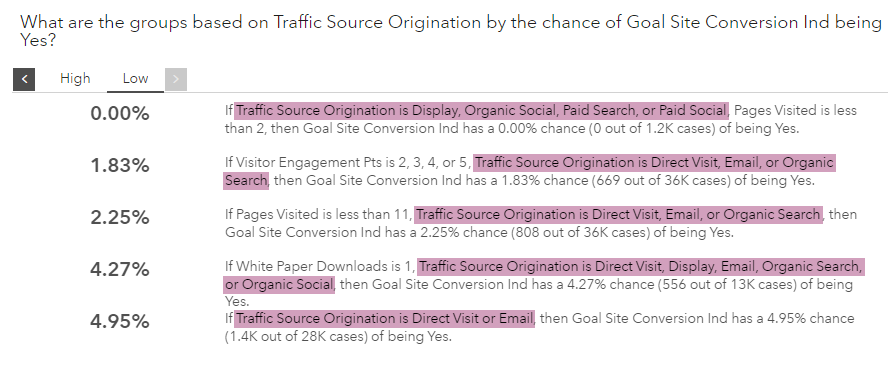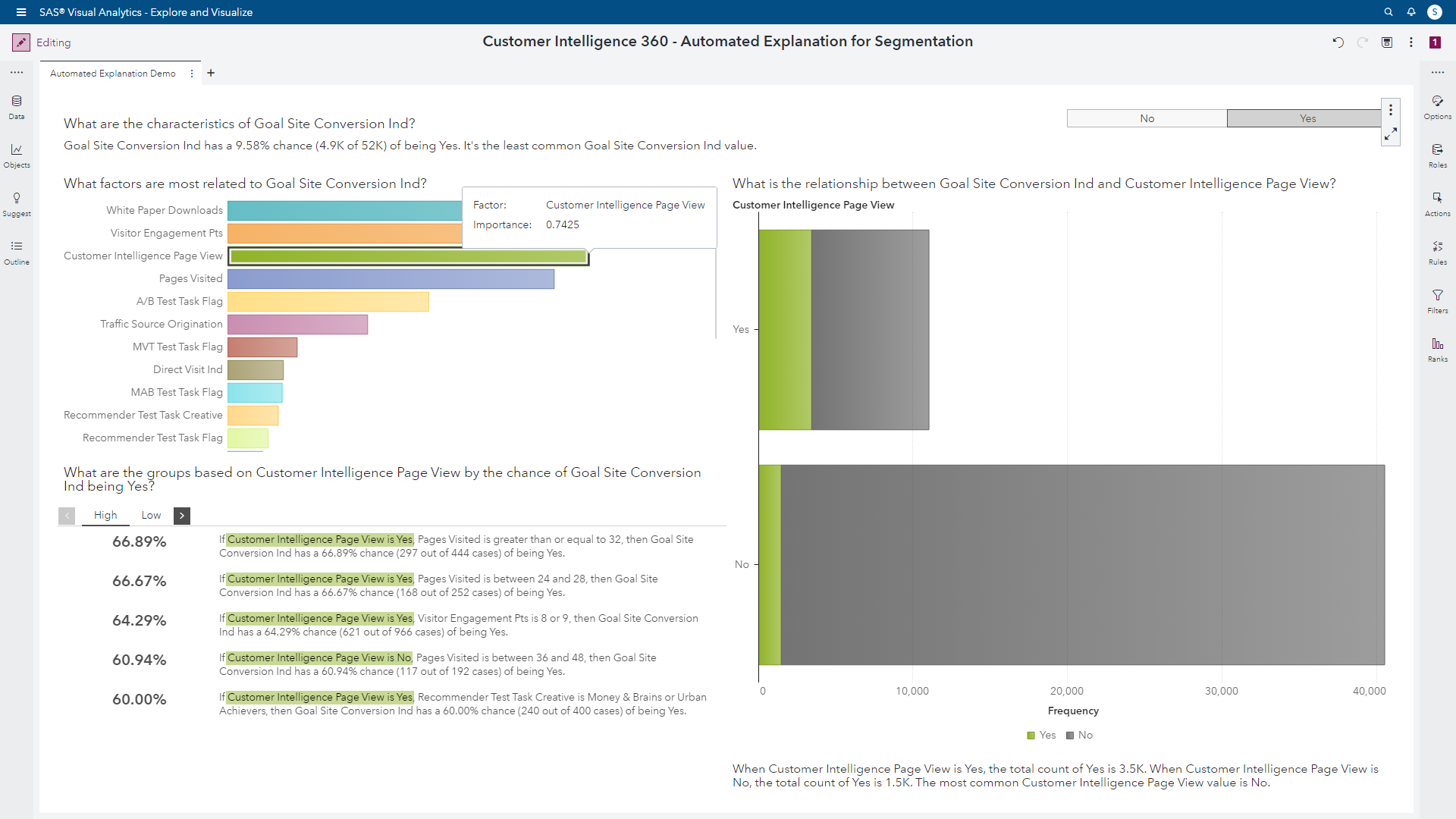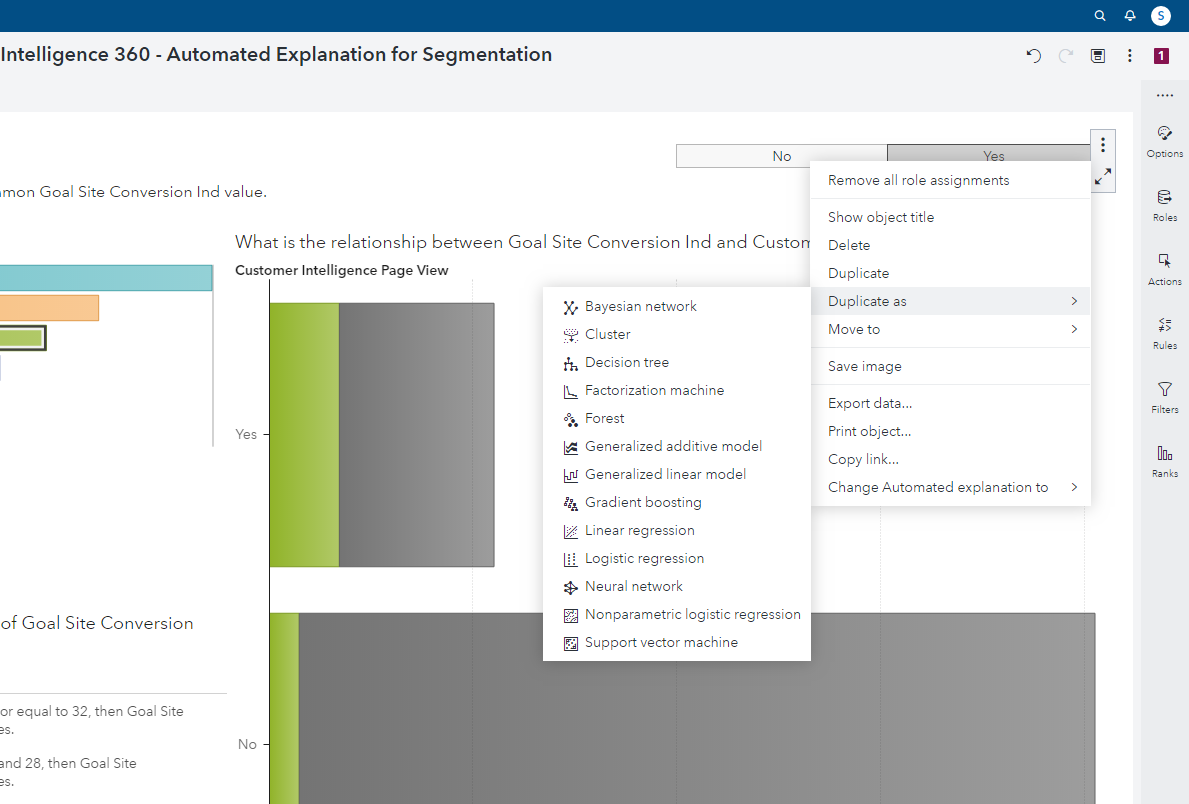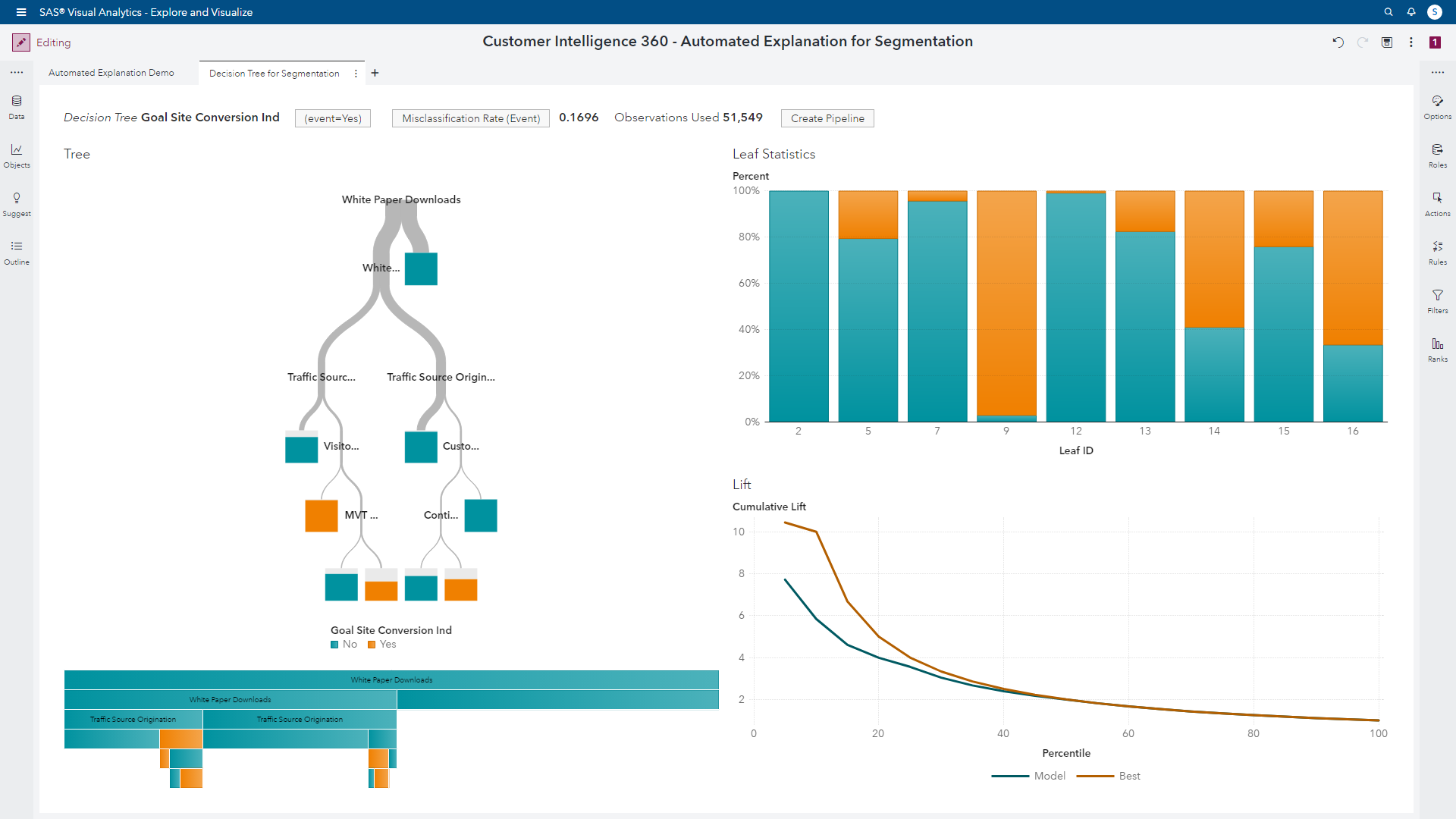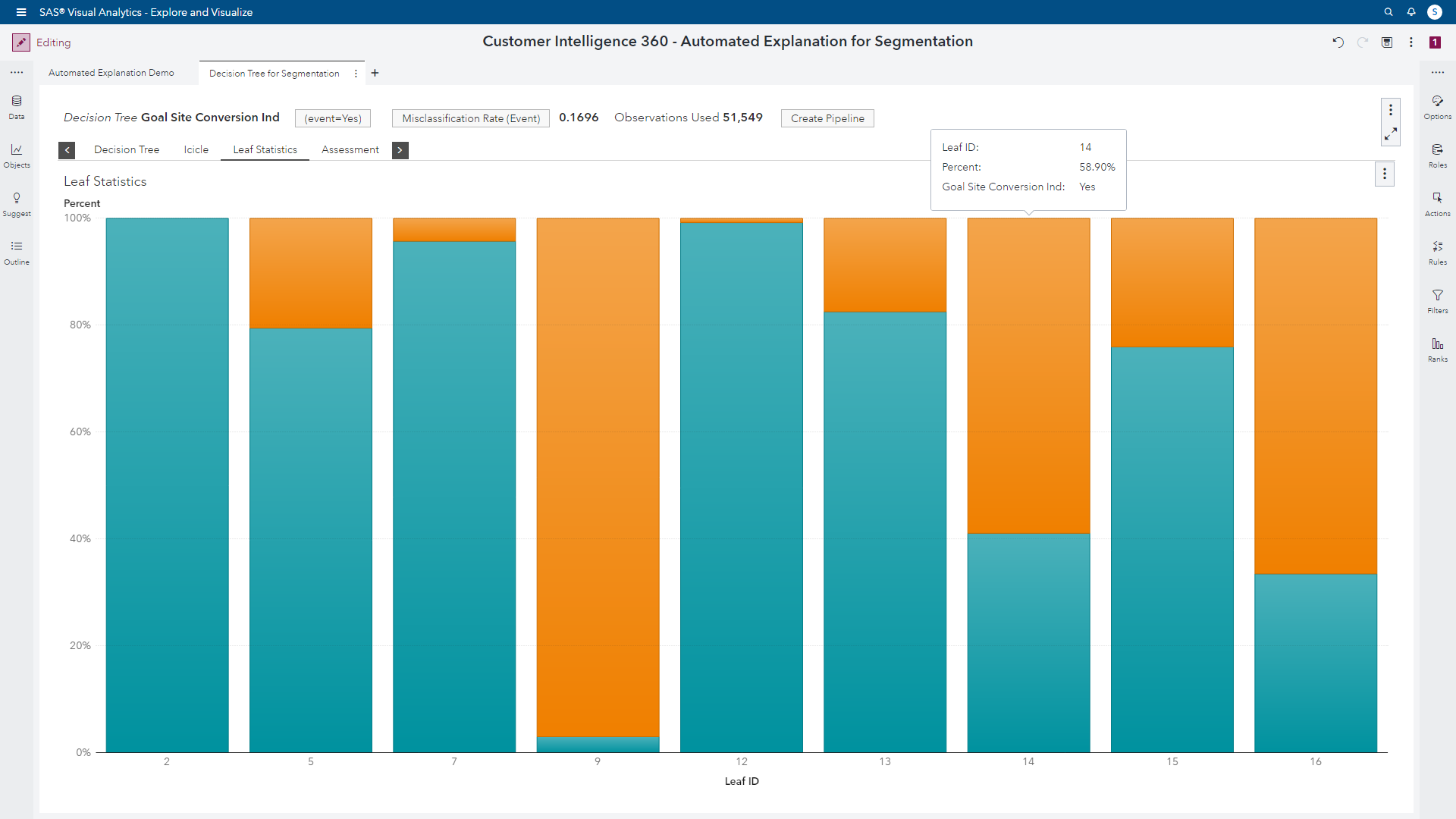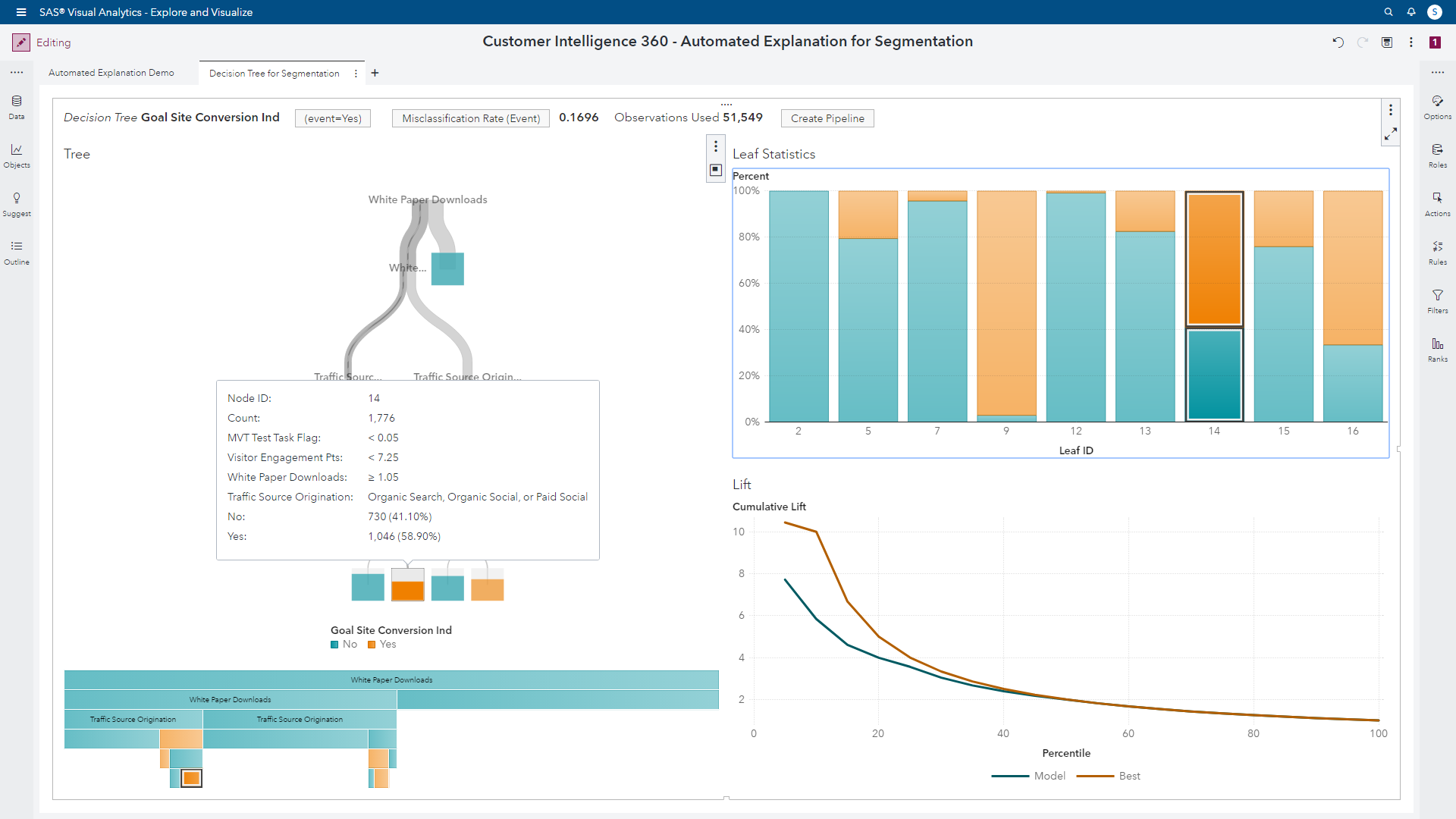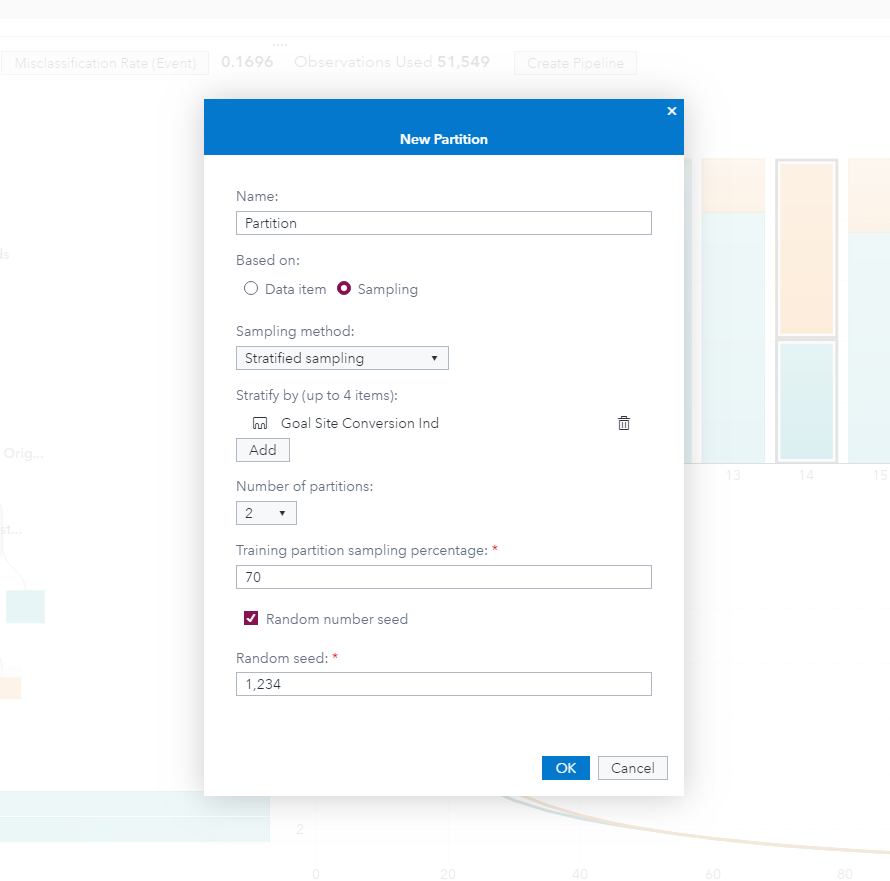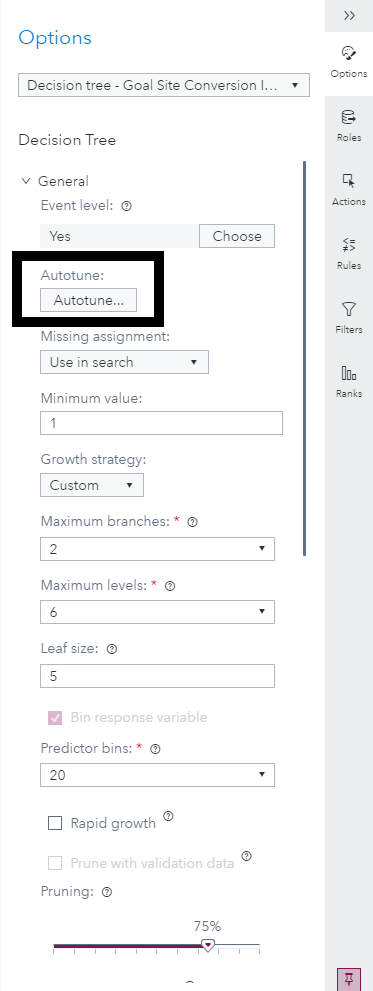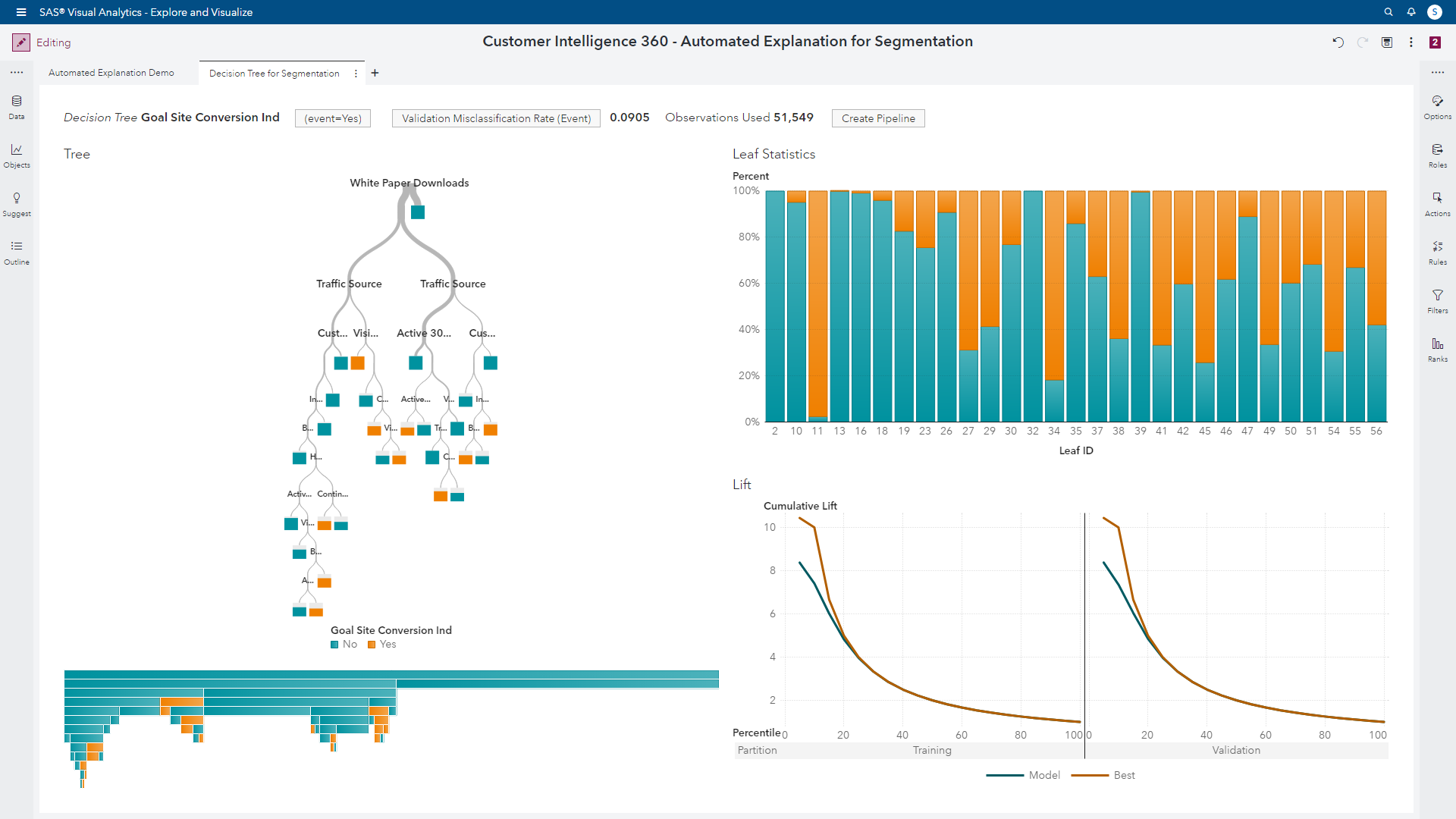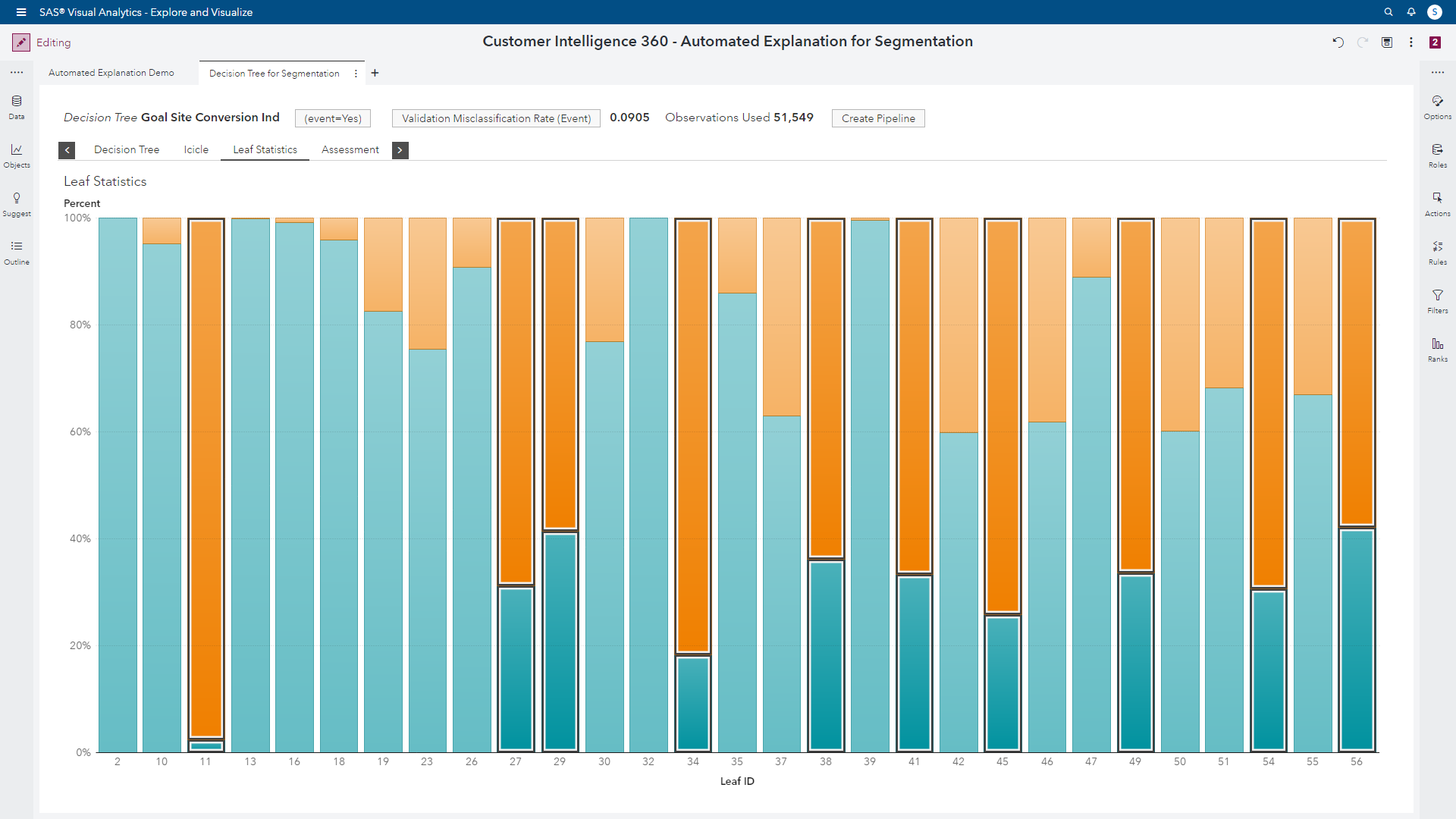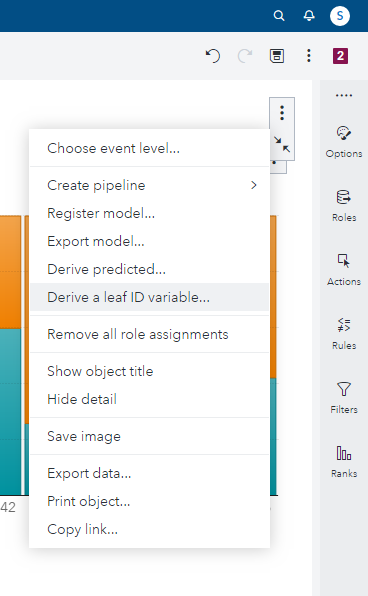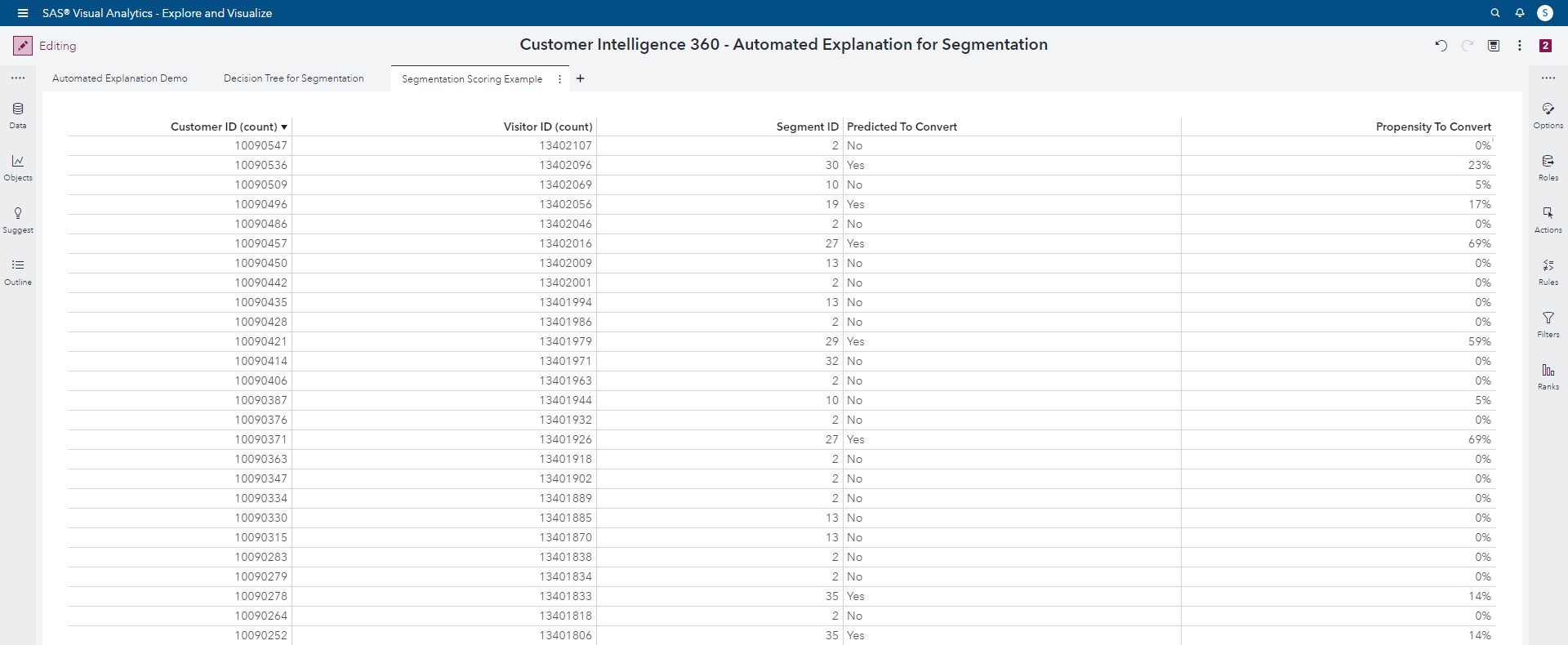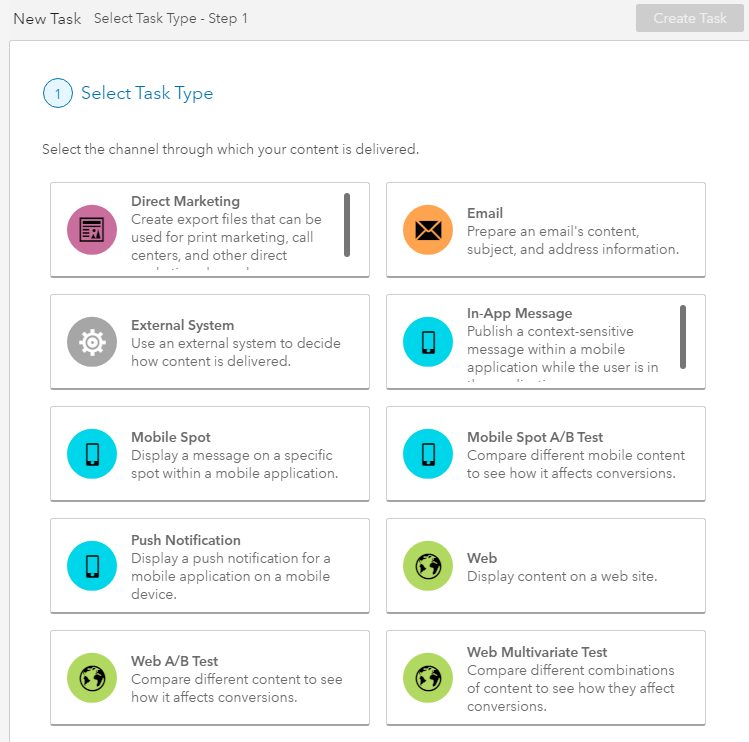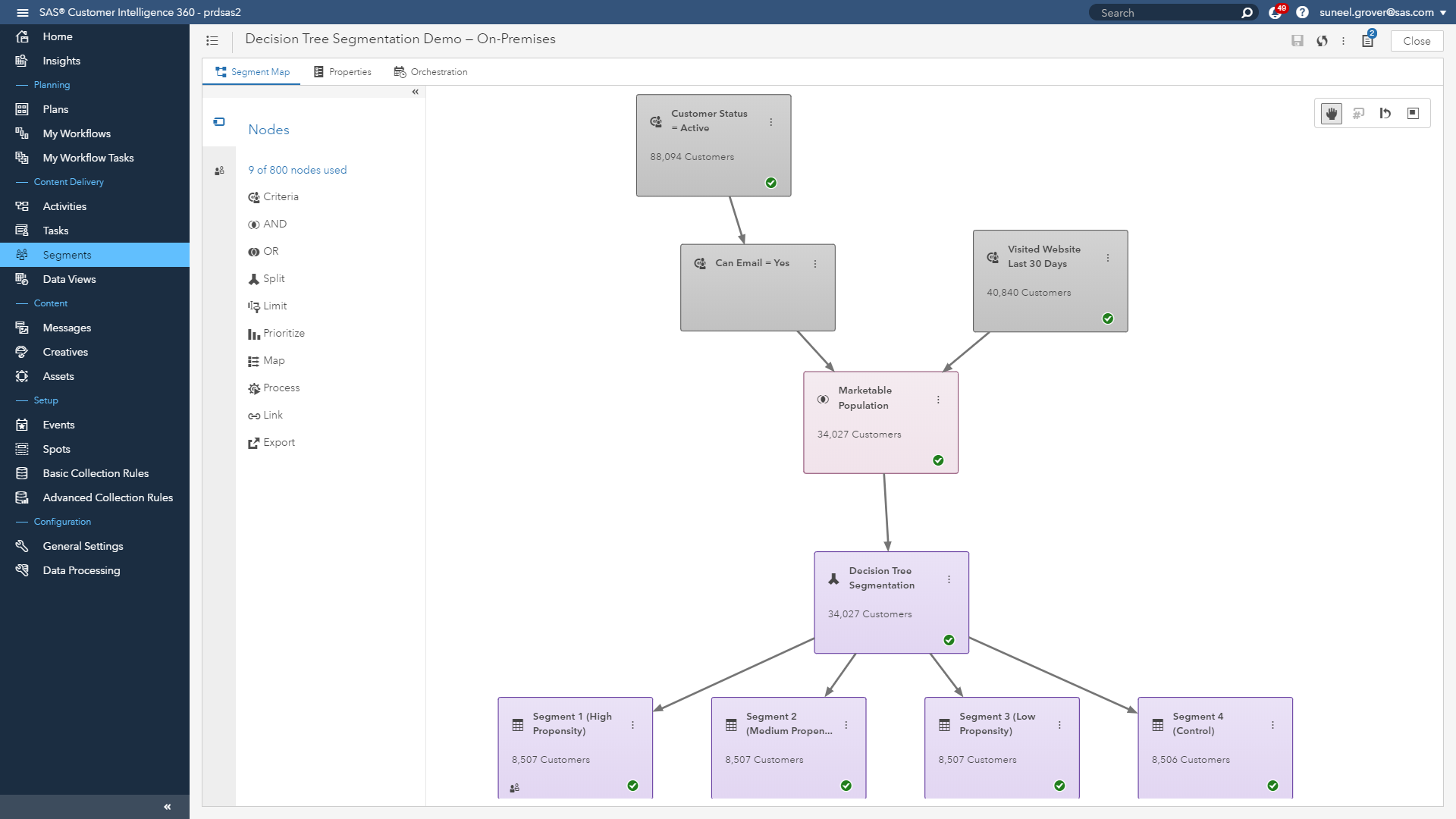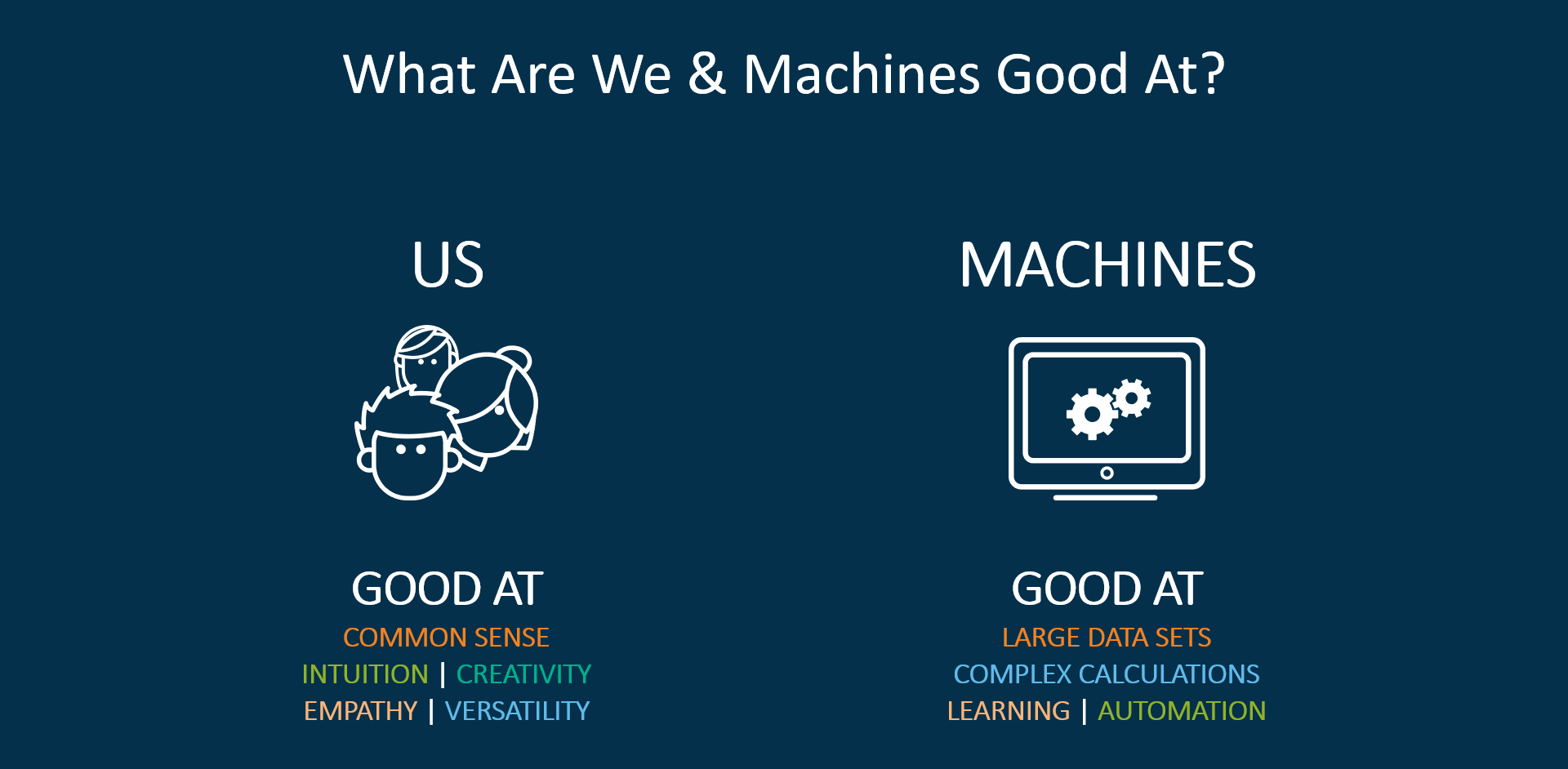- Home
- /
- SAS Communities Library
- /
- SAS Customer Intelligence 360: Automated AI, Natural Language Explanat...
- RSS Feed
- Mark as New
- Mark as Read
- Bookmark
- Subscribe
- Printer Friendly Page
- Report Inappropriate Content
SAS Customer Intelligence 360: Automated AI, Natural Language Explanation & Segmentation
- Article History
- RSS Feed
- Mark as New
- Mark as Read
- Bookmark
- Subscribe
- Printer Friendly Page
- Report Inappropriate Content
Marketers and brands have used segmentation as a technique to deliver customer personalization for communications, content, products, and services since the introduction of customer relationship management (i.e., CRM) and database marketing. Within the context of segmentation, there are a variety of applications, ranging from consumer demographics, psychographics, geography, digital behavioral events, and more. Over time, segmentation has proven its value, and brands continue to use this strategy across every stage of the customer journey:
- Acquisition
- Upsell/cross-sell
- Retention
- Winback
With that said, here are three exemplary goals that most organizations share as they measure the performance of their segmentation strategies:
- Did we sell more?
- Is our marketing more effective?
- Are we delighting customers?
Goals are specific strategies leveraged to accomplish business objectives. Let’s walk through one of the examples cited above.
What does sell more actually mean?
- Do x (more cross-sell or upsell efforts).
- Improve y (increase conversion rates).
- Reduce z (reduce abandon cart rates).
Segmentation plays a role within any brand’s efforts to improve these critical metrics. As analysts, we are frequently asked why a key metric is higher or lower than expected. Dashboards, reports, and visualizations can show audiences what happened, what is higher or lower than expected, but rarely answer the central question of why.
We can do better.
Every marketing analytic problem requires three key considerations.
- What data can we leverage?
- Is there an analytic method that can help us discover insight?
- How will we deploy on insight to take action?
Consideration 1: What data can we leverage?
Whenever I meet with clients, one of the first questions I pose in a meeting is:
Are you exploiting your 1st party data to its fullest potential?
Your brand’s 1st party data belongs to you, and only you. It can provide differentiating insights about attractive customer (and prospective) segments that none of your competitors have access to. That translates to data assets that are ripe for analytical exploitation. But how you capture this information can have a tremendous impact on it’s potential.
Leveraging data collection mechanisms, SAS Customer Intelligence 360 captures 1st party behavioral information across your brand’s digital customer experience. As visitor journeys flow across touchpoints, SAS integrates these data streams into structured views. Once normalized, the output provides a variety of aggregated tables of digital interactions, including views that accelerate a user to stitch online and offline data together deterministically, as well as perform algorithmic segmentation.
I don’t know about your experiences as an analyst, but mine never involved a senior leader opening a meeting with “I can’t wait to hear how data prep is going…”
They care about how your derived insights will alter strategies to improve performance metrics. Nothing else.
Take a step back from segmentation, and imagine the possibilities - users can select structured digital data to build analyses for:
- Identifiable traffic and next-best-action targeting.
- Anonymous traffic and macro/micro goal propensity targeting.
- Enabling recommendation systems.
There are other use cases, but my intent is to get your mind generating ideas. Now that 1st party digital data is within grasp, analysts can join this information with offline information sources, treat quality issues, transpose columns into zero-one predictors, perform analytical partitioning, and engineer features.
Prefer point and click? We got your back. Love to code? We didn’t forget about you either. Desire to decorate your digital journey data with third-party attributes? No problem. Here is an example of accessing information sourced from ESRI, although any external data provider applies.
Data preparation is an art, and enabling users at this stage of the segmentation process results in the differentiation of average vs. game-changing efforts.
Consideration 2: Is there an analytic method that can help us discover insight?
Once data is ready, analysts can perform exploratory visualization and artisanal modeling. Given that customer behavior varies over time when thinking about segmentation, there isn’t one algorithm that rules them all. Users are offered a variety of techniques to select for both supervised and unsupervised approaches.
One of the wonderful aspects about my client-facing role at SAS is the breadth of audiences that I get an opportunity to work with. No matter where you fall on this list:
- Data engineer
- Business analyst
- Citizen data scientist
- Data scientist
- Statistician
- Executive
One topic is certain. We all love data. It’s beautiful, surprising, inspiring, emotive, compelling, and persuasive. Data is power. But we only feel these emotions when we arrive at the infamous “ah-ha” moment of analysis that makes us leap out of our seats!
However, I never hear clients express how much free time they have. The feedback is typically centered on not having enough resources or talent to meet objectives. What if we could accelerate to “ah-ha” moments without sacrificing quality?
SAS has been investing in research and development efforts around analytical automation designed to support the needs of a business analyst and citizen data scientist, as well as a statistician or data scientist. The question I’d like to address is:
What makes analytical automation useful in assisting people who are making or influencing changes to improve performance outcomes?
At the end of the day, anyone working with data has the potential to persuade decision makers. According to Rick Styll’s proceeding paper from SAS Global Forum2019, there is a confluence of trends that is driving the demand, feasibility, and availability of automated analysis.
- Growing sizes of data (sensors, websites, apps, social, external, etc.).
- The awareness of the value that predictive analytics and machine learning enables has soared.
- Data scientists and available time are in limited supply.
- High-performance computing now enables interactive modeling on very large volumes of data.
- Cloud infrastructure and technology has reduced costs and deployment times dramatically.
- Natural language processing is making conversational analytics a reality.
Let’s walk through an analysis together that combines automated machine learning and natural language explanations of the segmentation results. The objective will be to derive actionable audiences who have higher propensities to meet our brand’s conversion goal (i.e. revenue-driving event). The benefit of this effort will provide guidance on who qualifies for marketing tactics like retargeting, personalization, and testing. In other words, which segments are worth targeting with our limited resources, and which aren’t.
The first step is to select the attribute in our data that represents the conversion event of interest, right-click, and select explain.
Automated explanation quickly determines the most important underlying factors (or predictors) for the conversion outcome by analyzing all of the rows and columns of the input data.
At the top of the page, a natural language generated overview of Goal Site Conversion Ind is displayed, including the percentage of observations that converted, as well as comparative details to other values represented within this attribute’s distribution.
Below the overview text section, color-coded factors on a horizontal bar chart are visualized displaying the relative importance of each attribute’s influence of Goal Site Conversion Ind. The most important predictors appear on the top, listed in descending order by weight. The weights are determined by one-level algorithmic decision trees. Hovering over each bar interactively generates a pop-up display of the relative importance score standardized between one and zero to simplify interpretation (higher values equate to more influence).
Now that an analyst knows which factors influence Goal Site Conversion Ind, how can they determine which data values of these important factors lead to higher or lower conversion propensities? When a data item like Goal Site Conversion Ind is selected to be analyzed, the automated analysis results display a list of attractive segments. These homogeneous groups receive natural language descriptions based on recipes of influential factors with specific values.
In the provided example, multi-level (as opposed to single-level) C4.5 decision trees are executed to identify each of the segments performing at high conversion rates, and analysts can review the explanations to assess the audience profiles. Since the factor Traffic Source Origination was selected, all influential values related to this attribute are contextually highlighted in purple. Not only does the analyst see the impact of the selected factor, but also how other factors interact with it to identify high value segments.
Alternatively, if an analyst is interested in low value segments, clicking the Low filter will present those audiences.
Moving on, analysts will want to explore the bivariate relationships of factors with Goal Site Conversion Ind in more detail to assist in both interpretation, and presentation storytelling. The last visualization appears on the right side of the report highlighting the interaction effect of a selected factor with Goal Site Conversion Ind.
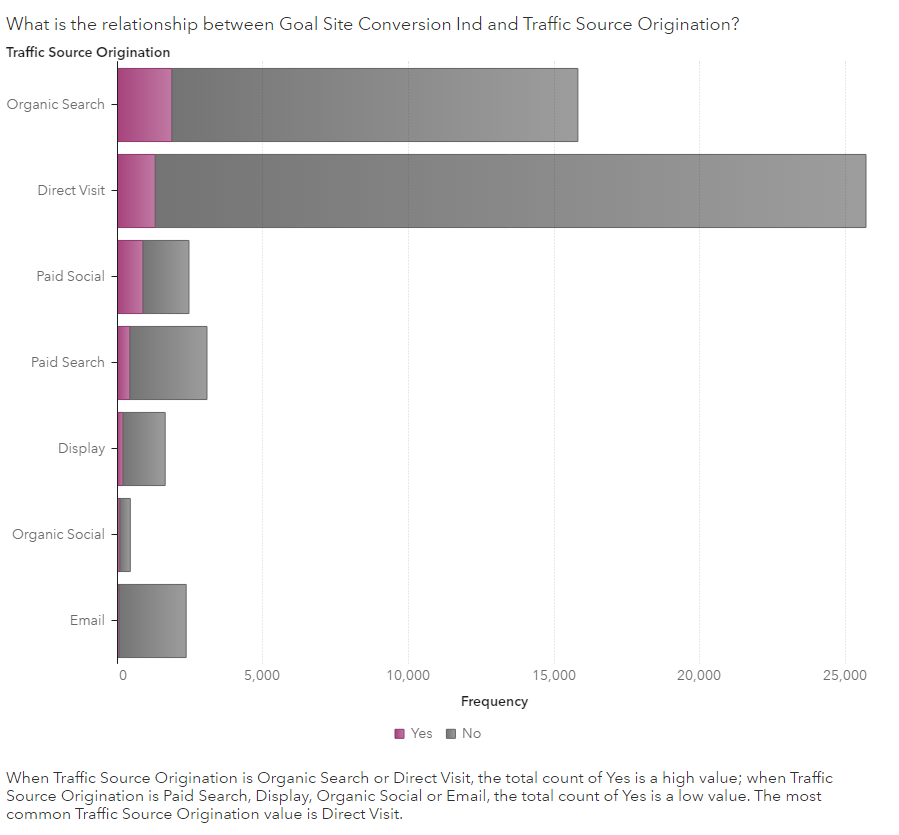
(Image 12: SAS Customer Intelligence 360 - Interactive bivariate analysis between target metric and selected factor)
Users can review the natural language explanations of the visualization, and also interactively select other influential factors. In the example below, I proceeded to select the factor Customer Intelligence Page View, and the report changes other visualizations to improve my understanding of the influence it has on Goal Site Conversion Ind, as well as it’s impact to identifying attractive segments.
How else can we exploit automated AI in defining actionable segments?
A powerful feature in SAS is the ability to increase analysis sophistication. Two examples I will highlight building from our previous effort will be:
- Switching the underlying algorithm of the analysis.
- Leverage model auto tuning (or hyperparameters).
To begin, I open a menu to duplicate my automated analysis to any of the listed techniques.
Although I can select any method, I will use a decision tree to show how an analyst can further optimize the effectiveness of their work. For readers interested in other machine learning techniques like forests, gradient boosting, or neural networks for classification use cases, check this out. Others curious on learning more about factorization machines for recommendation systems, go here.
After selecting decision tree, the analyst can visually assess the diagnostic metrics, but also has an opportunity to improve the segmentation. I’ll begin by reviewing the initial results.
In short, this output highlights nine segments with varying propensities to convert (or not convert) based on our Goal Site Conversion Ind target metric. By enlarging the segment leaf plot, an analyst can view which segments have attractive signals. The bars with larger proportions of orange color represent audiences with higher conversion propensities.
If an analyst selects a specific segment, the tree map interactively provides more context of the audience.
Analysts also desire stability in their work, and analytical model partitioning is turned on in a snap. This helps ensure the segmentation results will perform similarly on scoring new audiences.
A new challenge will inevitably present itself. The tree’s diagnostic metric of misclassification rate will haunt the analyst, and their efficiency to deliver results. In our current example, we have an error rate of approximately 17%. The analyst delivering this segmentation for use in campaign management processes will naturally want to improve the accuracy of the predictions. However, this can become a time-consuming exercise of manual iterations tinkering with the analysis and delaying the delivery of the results.
Once again, we can do better with automation.
To create a good segmentation model, many choices have to be made when deciding on algorithms and their parameters. The usual approach is to apply trial-and-error methods to find the optimal algorithms for the problem at hand. Often, an analyst will choose algorithms based on practical experience and personal preferences. This is reasonable, because usually there is no unique solution to create a machine learning model. Many algorithms have been developed to automate manual and tedious steps of the analytical process. Still, it requires a lot of time and effort to build a machine learning model with trustworthy results.
A large portion of this manual work relates to finding the optimal set of hyperparameters for a chosen modeling algorithm (in our use case, the decision tree). Hyperparameters are the properties that define the model applied to a data set for automated information extraction.
In our example, an analyst must make many decisions during the training process. A large portion of the segmentation model building process is taken up by experiments to identify the optimal set of parameters for the algorithm. As algorithms get more complex (single-layer to multi-layer neural networks, decision trees to forests and gradient boosting), the amount of time required to identify these parameters grows.
There are several ways to support analysts in the cumbersome work of tuning model parameters. These approaches are called hyperparameter optimization, or auto tuning. Not only do ideal settings for the hyperparameters dictate the performance of the model’s training process, but more importantly they govern the quality of the resulting segmentation model.
Watch this.
In a single click, an analyst can trigger the auto tuning optimization, and automate the removal of countless attempts to improve the segmentation analysis.
In general, there are three different types of auto tuning methods: parameter sweep, random search, and parameter optimization.
- Parameter sweep: This is an exhaustive search through a predefined set of parameter values. The analyst selects the candidates of values for each parameter to tune; trains a model with each possible combination; and selects the best-performing model. Here, the outcome very much depends on the experience and selection of the analyst.
- Random search: This is a search through a set of randomly selected sets of values for the model parameters. With modern computers, this can provide a less biased approach to finding an optimal set of parameters for the selected model. Since this is a random search, it is possible to miss the optimal set unless a sufficient number of experiments are conducted, which can be computationally expensive.
- Parameter optimization: This is the approach that applies modern optimization techniques to find the optimal solution. It is the best way to find the most appropriate set of parameters for any predictive model, and any business problem, in the least expensive way.
SAS provides analysts a hybrid, derivative-free optimization framework that operates in a parallel and distributed computing environment to overcome the challenges and computational expense of hyperparameter optimization. It consists of an extendable suite of search methods.
The result of clicking the auto tune button has a formidable impact on our segmentation analysis. The misclassification rate decreases from 17% to approximately 9%. That’s an 8% increase in predictive accuracy based on the validation partition of the input data. In other words, more accuracy will translate to improved conversion rates downstream.
Incremental lift was derived from audience deciles, as well as the identification of more attractive segments. The auto tuning actually helped the tree create thirty segments in total. Before leveraging this feature, our previous iteration of the tree analysis identified three segments with high value propensities to convert. Now we have ten segments with favorable behaviors available for audience targeting.
Analysts reading this who do not have access to auto tuning in their current analytical environments will appreciate the hours and days that could be saved to reach this ideal outcome.
Consideration 3: How will we deploy on insight to take action?
Let’s assume we are feeling confident about the results of our segmentation analysis. Now is the time to share the prescription with the marketing teams who manage content delivery across touchpoints. The audience segments from the analysis could be used for direct, email, web, mobile, or other interaction types. Look-a-like targeting, remarketing, and testing are all attainable use cases.
To begin the hand-off, the analyst simply needs to score customer (or prospect) records with the model’s scoring logic.
Here is an example of what scored data would look like.
Rest assured, there are different approaches in making analytically scored data available within (and outside) of SAS beyond a table. What options do analysts have in helping their marketing teams?
- The ability to target segments in batch or real-time.
- Access to the segmentation scoring engine (SAS, Python or REST) for APIs through SAS analytic services.
In summary, the analyst can pass the algorithmic-defined segments for the marketer to take action on. Whether the strategy is to target audiences in one or multiple channels across journeys, SAS Customer Intelligence 360 supports content delivery for a variety of interaction types.
Within the platform, audiences can be defined using business rules, conditional logic, and algorithmic scoring. Let’s highlight a myriad of targeting rules through the eyes of a marketing technologist familiar with the automation of campaign management processes. The requirements for this targeting waterfall example are as follows:
- Customer status eligibility is ACTIVE.
- Email marketing permission flag is set to YES.
- Visited website in the last 30 DAYS.
- After these first three rules have been applied, the resulting marketable audience is available for the decision tree segmentation scoring.
- Create segment quartiles based on high, medium, and low propensity groupings, as well as a control group.
Once the segments are published, the marketing team has both the transparent understanding of the audiences due to the robust analysis, as well as the ability to test the effectiveness of the analytical recommendations within a singular touchpoint interaction, or customer journeys across multiple touchpoints.
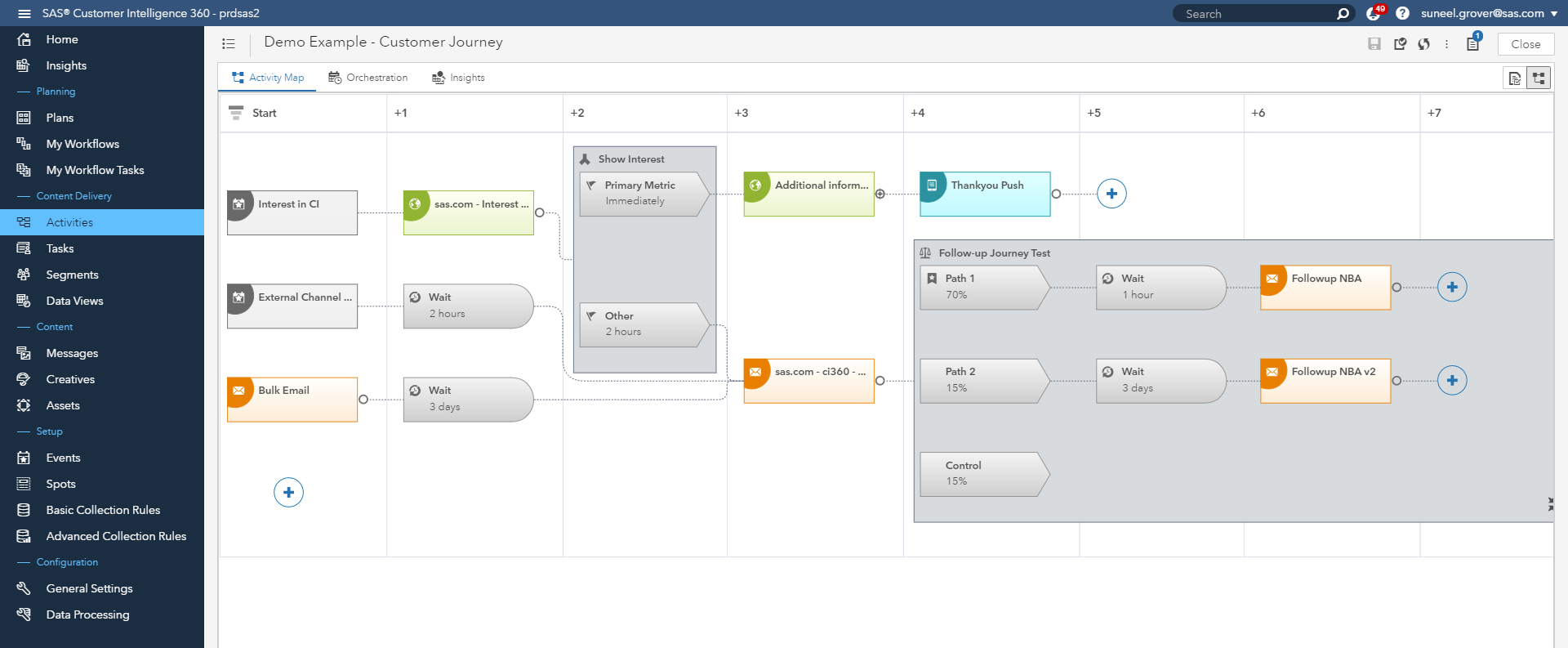
(Image 27: SAS Customer Intelligence 360 - Multi-channel customer journey targeting and personalization)
Allow me to close with a peek into the design principles of SAS Customer Intelligence 360, where the technology is intended to resemble the anatomy of the human brain. There are two distinct hemispheres.
The left hemisphere is associated with analytical, logical and fact-oriented thinking. The right side is associated with creative, intuitive, and visual thinking. This translates to:
- The strength of the left side links tightly with authoring and deploying predictive and machine learning models.
- The right side facilitates the orchestration layer of marketing activity across planning, creative and operations.
Together the intent is to better understand and manage customer activity, regardless of channel, in alignment with a brand’s goals and objectives. At the end of the day, the analytical minded, and the creative minded, need to be in lock step with one another. This is how the whole-brain approach of SAS Customer Intelligence 360.
Within this viewpoint, AI has the power to transform the world around us and analytics is at the heart of delivering on this promise. SAS embeds advanced AI capabilities into the platform, to support initiatives from start to finish. We have covered tremendous ground in this article, highlighting multiple examples of AI augmenting human abilities.
Turn insights into action by embedding AI within your marketing process by completing the last mile, and transforming hype into reality. To learn more about how the SAS platform can be applied to other marketing and customer-centric use cases, check out additional posts here.
April 27 – 30 | Gaylord Texan | Grapevine, Texas
Registration is open
Walk in ready to learn. Walk out ready to deliver. This is the data and AI conference you can't afford to miss.
Register now and lock in 2025 pricing—just $495!
SAS AI and Machine Learning Courses
The rapid growth of AI technologies is driving an AI skills gap and demand for AI talent. Ready to grow your AI literacy? SAS offers free ways to get started for beginners, business leaders, and analytics professionals of all skill levels. Your future self will thank you.
- Find more articles tagged with:
- CI360 with Suneel
